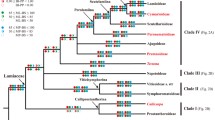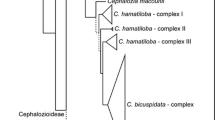Abstract
Phylogenetic relationships within the angiosperm orderCampanulales were investigated by comparative sequencing of the chloroplast generbcL. CompleterbcL sequences were obtained for ten species in six families within the order. These data were analyzed along with previously publishedrbcL sequences from other taxa (for a total of 117 species) within the subclassAsteridae and outgroups, producing 32 equally parsimonious trees. A subset consisting of 44 of these taxa was then chosen and more rigorous analyses performed, resulting in four equally parsimonious trees. Results indicate that two major clades roughly corresponding to traditionally circumscribedAsterales andCampanulales exist as sister taxa. In particular, therbcL trees indicate thatSphenoclea is not a member ofCampanulales orAsterales, thatPentaphragma is more closely allied toAsterales thanCampanulales, that theCyphiaceae are not monophyletic, thatCampanulaceae andLobeliaceae are not sister taxa, and thatStylidiaceae are correctly placed withinCampanulales.
Similar content being viewed by others
References
Airy Shaw, H. K., 1942: Additions to the flora of Borneo and other Malay islands: XIX. ThePentaphragmataceae of the Oxford University expedition to Sarawak, 1932. — Bull. Misc. Inform. 1941: 233–236.
—, 1948:Sphenocleaceae. — Invan Steenis, C. G. G. J., (Ed.): Flora Malesiana, ser 1, 4/1, pp. 27–28. — Djakarta: Noordhoff-Kolff.
—, 1954:Pentaphragmataceae. — Invan Steenis, C. G. G. J., (Ed.): Flora Malesiana, ser 1, 4/1, pp. 517–528. — Djakarta: Noordhoff-Kolff.
—, 1973: A dictionary of the flowering plants and ferns. 8th edn. — Cambridge, England: Cambridge University Press.
Bentham, G., 1875: Notes on the gamopetalous orders belonging to the campanulaceous and oleaceous groups. — J. Linn. Soc. Bot.15: 1–16.
Brown, R., 1818: Observations, systematical and geographical, on ProfessorChristian Smith's collection of plants from the vicinity of the river Congo. — InTuckey, J. K., (Ed.): Narrative of an expedition to explore the river Zaire, pp. 420–485.
Carlquist, S., 1989: Wood anatomy and relationships ofMontinia. — Aliso12: 369–378.
Chase, M. W., Soltis, D. E., Olmstead, R. G., Morgan, D., Les, D. H., Mishler, B. D., Duvall, M. R., Price, R., Hills, H. G., Qui, Y.-L., Kron, K. A., Rettig, J. H., Conti, E., Palmer, J. D., Manhart, J. R., Sytsma, K. J., Michaels, H. J., Kress, W. J., Donoghue, M. J., Clark, W. D., Hedron, M., Gaut, B. S., Jansen, R. K., Kim, K.-J., Wimpee, C. F., Smith, J. F., Furnier, G. R., Strauss, S. H., Xiang, Q.-Y., Plunkett, G. M., Soltis, P. S., Swensen, S., Eguiarte, L. E., Learn, G. H., Barrett, S. C. H., Graham, S., Dayanandan, S., Albert, V. A., 1993: Phylogenetics of seed plants: an analysis of nucleotide sequences from the plastid generbcL. — Ann. Missouri Bot. Gard.80: 528–580.
Choisy, J. D., 1833: Description des Hydroléacées. — Mém. Soc. Phys. Genéve6: 95–122.
Constance, L., 1963: Chromosome number and classification inHydrophyllaceae. — Brittonia15: 273–285.
Cronquist, A., 1981: An integrated system of flowering plants. — New York: Columbia University Press.
—, 1988: The evolution and classification of flowering plants, 2nd edn. — Bronx, New York: New York Bot. Gard.
Dahlgren, G., 1989a: The last Dahlgrenogram. System of classification of the dicotyledons. — InTan, K., (Ed.): Plant taxonomy, phytogeography and releated subjects: The Davis and Hedge Festschrift, pp. 249–260. — Edinburgh: Edinburgh University Press.
—, 1989b: An updated angiosperm classification. — Bot. J. Linn. Soc.100: 197–203.
Dahlgren, R. M. T., 1980: A revised system of classification of the angiosperms. — Bot. J. Linn. Soc.80: 91–124.
—, 1983: General aspects of angiosperm evolution and macrosystematics. — Nordic J. Bot.3: 119–149.
—, 1977: Seedling morphology and iridoid occurrence inMontinia caryophyllacea (Montiniaceae). — Bot. Not.130: 329–332.
—, 1981: A revised classification of the angiosperms with comments on correlation between chemical and other characters. — InYoung, D. A., Seigler, S., (Eds): Phytochemistry and angiosperm evolution, pp. 149–204. — New York: Praeger.
deCandolle, A. P., 1830: Monographie des Campanulées. — Paris.
Donoghue, M. J., Olmstead, R. G., Smith, J. F., Palmer, J. D., 1992: Phylogenetic relationships ofDipsacales based onrbcL sequences. — Ann. Missouri Bot. Gard.79: 333–345.
Downie, S. R., Palmer, J. D., 1992: Restriction site mapping of the chloroplast DNA inverted repeat: a molecular phylogeny of theAsteridae. — Ann. Missouri Bot. Gard.79: 266–283.
Doyle, J. J., 1992: Gene trees and species trees: molecular systematics as one-character taxonomy. — Syst. Bot.17: 144–163.
—, 1987: A rapid isolation procedure for small quantities of fresh leaf tissue. — Phytochem. Bull.19: 11–15.
Dunbar, A., 1975a: On pollen ofCampanulaceae and related families with special reference to the surface ultrastructureI.Campanulaceae subfam.Campanuloideae. — Bot. Not.128: 73–101.
—, 1975b: On pollen ofCampanulaceae and related families with special reference to the surface ultrastructure II.Campanulaceae subfam.Cyphioideae and subfam.Lobelioideae; Goodeniaceae; Sphenocleaceae. — Bot. Not.128: 102–118.
—, 1978: Pollen morphology and taxonomic position of the genusPentaphragma Wall. (Pentaphragmataceae). The use of compound fixatives. — Grana17: 141–147.
—, 1984: Pollen morphology inCampanulaceae IV. — Nordic J. Bot.4: 1–19.
—, 1976: On pollen ofCampanulaceae III. A numerical taxonomic investigation. — Bot. Not.129: 69–72.
Erbar, C., 1992: Floral development of two species ofStylidium (Stylidiaceae) and some remarks on the systematic position of the familyStylidiaceae. — Canad. J. Bot.70: 258–271.
Eyde, R. N., 1966: Systematic anatomy of the flower and fruit ofCorokia. — Amer. J. Bot.53: 833–847.
—, 1988: ComprehendingCornus: puzzles and progress in the systematics of the dogwoods. — Bot. Rev.54: 233–351.
Fedorov, A. A., 1972:Campanulaceae. — InShishkin, B. K., (Ed.): Flora of the U.S.S.R., pp. 92–363. — Moscow, Leningrad: Akademia Nauk SSSR.
Felsenstein, J., 1985: Confidence limits on phylogenies: an approach using the bootstrap. — Evolution39: 783–791.
Hillis, D. M., Dixon, M. T., 1989: Vertebrate phylogeny: evidence from 28S ribosomal DNA sequences. — InFernholm, B. & al., (Eds): The hierarchy of life, Nobel Symposium 70, pp. 355–367. — Amsterdam: Elsevier.
Hong, D.-Y., Ma, L.-M., 1991: Systematics of the genusCyananthus Wall. exRoyle. — Acta Phytotax. Sin.29: 25–51.
Hutchinson, J., 1969: Evolution and phylogeny of flowering plants. — London: Academic Press.
—, 1973: The families of flowering plants. 3rd edn. — Oxford: Clarendon Press.
Jensen, S. R., Nielsen, B. J., Dahlgren, R., 1975: Iridoid compounds, their occurrence and systematic importance in angiosperms. — Bot. Not.128: 148–180.
Kapil, R. N., Vijayaraghavan, M. R., 1965: Embryology ofPentaphragma horsfieldii (Miq.)Airy Shaw with a discussion on the systematic position of the genus. — Phytomorphology15: 93–102.
Kaplan, M. A. C., Gottlieb, O. R., 1982: Iridoids as systematic markers in dicotyledons. — Biochem. Syst. Ecol.10: 329–347.
Kovanda, M., 1978: Campanulaceae. — InHeywood, V. H., (Ed.): Flowering plants of the world, pp. 254–256. — New York: Mayflower Books.
Lammers, T. G., 1992: Circumscription and phylogeny of theCampanulales. — Ann. Missouri Bot. Gard.79: 388–413.
Leins, P., 1964: Entwicklungsgeschichtliche Studien anEricales-Blüten. — Bot. Jahrb. Syst.83: 57–88.
Maddison, D. R., 1991: The discovery and importance of multiple islands of most parsimonious trees. — Syst. Zool.40: 315–328.
Michaels, H. J., Scott, K. M., Olmstead, R. G., Szaro, T., Jansen, R. K., Palmer, J. D., 1993: Interfamilial relationships of theAsteraceae: insights fromrbcL sequence variation. — Ann. Missouri Bot. Gard.80: 742–751.
Morgan, D. R., Soltis, D. E., 1993: Phylogenetic relationships among members ofSaxifragaceae sensu lato based onrbcL sequence data. — Ann. Missouri Bot. Gard.80: 631–660.
Olmstead, R. G., Bremer, B., Scott, K. M., Palmer, J. D., 1993: A parsimony analysis of theAsteridae sensu lato based onrbcL sequences. — Ann. Missouri Bot. Gard.80: 700–722.
—, 1992: Monophyly of theAsteridae and identification of their major lineages inferred from DNA sequences ofrbcL. — Ann. Missouri Bot. Gard.79: 249–265.
Patel, R. N., 1973: Wood anatomy of the dicotyledons indigenous to New Zealand. 2.Escalloniaceae. — New Zealand J. Bot.11: 421–434.
Pollard, C. J., Amuti, K. S., 1981: Fructose oligosaccharides: possible markers of phylogenetic relationships among dicotyledonous plant families. — Biochem. Syst. Ecol.9: 69–78.
Rosatti, T. J., 1986: The genera ofSphenocleaceae andCampanulaceae in the southeastern United States. — J. Arnold Arbor.67: 1–64.
Schönland, S., 1889:Campanulaceae. — InEngler, A., Prantl, K., (Eds): Die natürlichen Pflanzenfamilien IV, 5, pp. 40–70. — Leipzig: Engelmann.
Swofford, D. L., 1993: PAUP: phylogenetic analysis using parsimony, version 3.1.1. — Champaign, Illinois: Natural History Survey.
Takhtajan, A. L., 1980: Outline of the classification of flowering plants (Magnoliophyta). — Bot. Rev. (Lancaster)46: 225–359.
—, 1987: SystemaMagnoliophytorum. — Leningrad: Nauka.
Thorne, R. F., 1976: A phylogenetic classification of the angiosperms. — InHecht, M. K., Steere, W. C., Wallace, B., (Eds): Evolutionary biology, pp. 35–106. — New York: Plenum Press.
—, 1992: Classification and geography of the flowering plants. — Bot. Rev.58: 225–348.
Thulin, M., 1975: The genusWahlenbergia s. lat. (Campanulaceae) in tropical Africa and Madagascar. — Symb. Bot. Upsal.21: 1–223.
Wagenitz, G., 1964: ReiheCampanulales. — InMelchior, H. (Ed.): A. Engler's Syllabus der Pflanzenfamilien 2. 12th edn., pp. 478–497. — Berlin: Bornträger.
Wimmer, F. E., 1968:Campanulaceae-Lobelioideae Supplementum etCampanulaceae-Cyphioideae. — InStubbe, H., (Ed.): Das Pflanzenreich 4, 276c, pp. i-x + 815–1024. — Berlin: Akademie-Verlag.
Winship, P. R., 1989: An improved method for directly sequencing PCR amplified material using dimethyl sulfoxide. — Nucleic Acids Res.17: 1266.
Author information
Authors and Affiliations
Rights and permissions
About this article
Cite this article
Cosner, M.E., Jansen, R.K. & Lammers, T.G. Phylogenetic relationships in theCampanulales based onrbcL sequences. Pl Syst Evol 190, 79–95 (1994). https://doi.org/10.1007/BF00937860
Received:
Accepted:
Issue Date:
DOI: https://doi.org/10.1007/BF00937860




